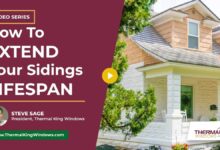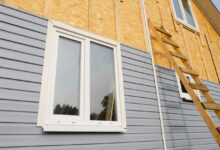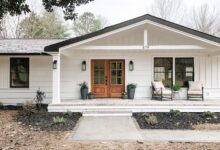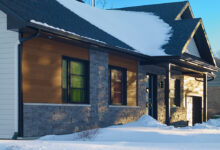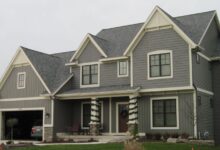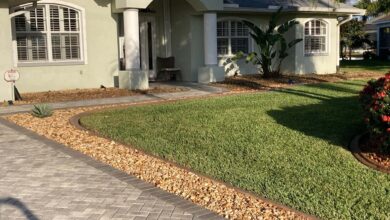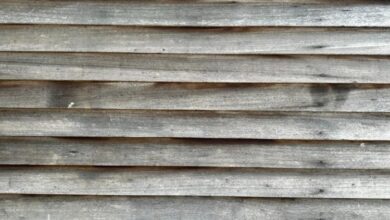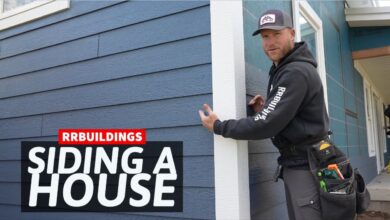Durable Siding for Coastal Properties
Durable Siding for Coastal Properties presents a unique challenge: safeguarding homes against the harsh coastal environment. Salt spray, relentless sun, and powerful winds relentlessly degrade traditional siding materials, demanding robust solutions. This exploration delves into the properties of various durable siding options, examining their resistance to coastal elements and providing insights into cost-effective, long-lasting choices for coastal homeowners.
We’ll examine the specific challenges posed by coastal climates, comparing the performance of materials like fiber cement, vinyl, engineered wood, and aluminum. We’ll also cover crucial installation techniques, maintenance strategies, and relevant building codes to ensure your coastal property remains protected and aesthetically pleasing for years to come. The aim is to equip you with the knowledge needed to make informed decisions about protecting your investment.
Defining Coastal Property Challenges
Coastal properties, while idyllic, present unique and significant challenges for building materials, particularly siding. The relentless assault of the marine environment demands careful consideration of material selection to ensure longevity and minimize costly repairs. Understanding these challenges is crucial for making informed decisions about siding choices.
Coastal environments subject building materials to a complex interplay of harsh conditions. These conditions significantly accelerate the degradation process compared to inland locations.
Environmental Factors Affecting Coastal Siding
The coastal environment presents a trifecta of destructive forces: salt spray, intense sun exposure, and high humidity. Salt spray, carried by wind, deposits a fine layer of salt crystals on all exposed surfaces. This salt not only corrodes many metals but also draws moisture from materials, leading to swelling, cracking, and eventual failure. The intense sun, particularly in coastal regions with high UV index, accelerates the fading and degradation of many siding materials. High humidity, often coupled with salt spray, creates a breeding ground for mold and mildew, further compromising the structural integrity and aesthetic appeal of the siding. Finally, strong coastal winds can exacerbate the damage caused by salt spray and sun exposure by constantly abrading surfaces and driving moisture deeper into the material.
Material Degradation Mechanisms in Coastal Environments
Several mechanisms contribute to the accelerated degradation of siding materials in coastal areas. Salt crystallization, as previously mentioned, is a major culprit. The salt crystals grow within the pores of the material, causing internal stresses that lead to cracking and spalling. UV degradation breaks down the polymer chains in many synthetic materials, leading to fading, embrittlement, and loss of strength. Moisture absorption, exacerbated by high humidity and salt spray, can cause swelling, warping, and rotting, particularly in wood siding. Biological degradation, in the form of mold, mildew, and insect infestation, further weakens the siding and reduces its lifespan.
Lifespan of Common Siding Materials in Coastal Environments
The table below compares the typical lifespan, cost, and maintenance requirements of common siding materials under coastal conditions. It’s important to note that these are estimates and actual lifespans can vary depending on specific factors like material quality, installation techniques, and the severity of the coastal environment.
| Material | Lifespan (Years) | Cost (Relative) | Maintenance |
|---|---|---|---|
| Wood | 10-15 (with significant maintenance) | Medium-High | High (regular painting, sealing, repairs) |
| Vinyl | 20-30 | Medium | Low (occasional cleaning) |
| Fiber Cement | 25-50 | High | Medium (periodic painting) |
Material Properties of Durable Siding
Choosing the right siding for a coastal home requires careful consideration of material properties. Exposure to salt spray, intense UV radiation, and moisture necessitates materials with exceptional durability and resistance to degradation. The following sections compare and contrast several popular siding options, highlighting their strengths and weaknesses in coastal environments.
Fiber Cement Siding Properties
Fiber cement siding, a composite material of cement, cellulose fibers, and sand, offers excellent resistance to fire, rot, and insects. Its inherent strength provides significant impact resistance. However, its susceptibility to moisture absorption, if not properly sealed and maintained, can lead to cracking and damage over time. Exposure to salt spray can accelerate this process, demanding meticulous attention to surface sealing and regular cleaning. While fiber cement is relatively resistant to UV radiation, prolonged exposure can lead to some fading.
Vinyl Siding Properties
Vinyl siding is known for its affordability and low maintenance requirements. It’s inherently resistant to moisture and rot, making it suitable for humid coastal climates. However, vinyl’s resistance to impact damage is lower than fiber cement or engineered wood. It can also be susceptible to fading from prolonged UV exposure, especially in intensely sunny coastal areas. Salt spray can potentially degrade the vinyl over time, though less dramatically than with some other materials.
Engineered Wood Siding Properties
Engineered wood siding, often treated with preservatives to enhance its durability, offers a natural aesthetic appeal. Its strength and resistance to impact are generally good. However, its susceptibility to moisture absorption remains a significant concern in coastal environments. If not properly sealed and maintained, engineered wood siding can be prone to rot and insect infestation. While treated wood offers improved UV resistance, it’s still more vulnerable than fiber cement or vinyl. Salt spray can also damage untreated wood significantly faster.
Aluminum Siding Properties
Aluminum siding boasts exceptional resistance to corrosion, making it an excellent choice for coastal environments. It’s lightweight, easy to install, and requires minimal maintenance. Its resistance to salt spray, moisture, and UV radiation is superior to many other options. However, aluminum siding can dent easily and is less resistant to impact damage than fiber cement or engineered wood. Furthermore, it can be prone to scratching and may not offer the same aesthetic warmth as other materials.
Comparison Table: Siding Materials for Coastal Homes
| Material | Advantages | Disadvantages | Suitability for Coastal Environments |
|---|---|---|---|
| Fiber Cement | High strength, fire resistance, rot resistance, insect resistance | Susceptible to moisture damage if not properly sealed, can crack, relatively expensive | Good with proper sealing and maintenance |
| Vinyl | Affordable, low maintenance, moisture resistant | Susceptible to impact damage, can fade with UV exposure, less durable than other options | Moderate; requires careful consideration of sun exposure |
| Engineered Wood | Natural aesthetic, good strength (when treated), relatively affordable | Susceptible to moisture damage and rot if not treated properly, requires regular maintenance | Fair; requires thorough treatment and regular maintenance |
| Aluminum | Excellent corrosion resistance, low maintenance, lightweight | Susceptible to dents and scratches, less aesthetically pleasing than other options | Excellent; highly resistant to coastal elements |
Installation and Maintenance Considerations
Proper installation and regular maintenance are crucial for maximizing the lifespan and performance of durable siding on coastal properties. Coastal environments present unique challenges, including high humidity, salt spray, and strong winds, all of which can accelerate deterioration if not addressed during installation and ongoing maintenance. Careful attention to detail during both phases is essential to protect your investment and maintain the aesthetic appeal of your home.
Proper Installation Techniques for Coastal Areas
Preventing moisture intrusion is paramount in coastal areas. This requires meticulous attention to detail during the installation process. For example, using flashing and sealants at all vulnerable points, such as around windows, doors, and corners, is critical to prevent water from penetrating the siding system. Furthermore, ensuring proper ventilation behind the siding allows for moisture to escape, reducing the risk of mold and mildew growth. The use of corrosion-resistant fasteners is also vital, as standard fasteners can quickly degrade in the salty air. Consider using stainless steel or other marine-grade materials. Finally, installers should follow the manufacturer’s specific instructions for their chosen siding material, as these instructions often contain valuable guidance on proper installation techniques for coastal applications. A well-installed siding system will act as a robust barrier against the harsh coastal elements.
Recommended Maintenance Procedures for Different Siding Materials
The maintenance requirements vary depending on the siding material chosen. For example, vinyl siding, a popular choice for coastal homes due to its low maintenance nature, typically requires only occasional cleaning with a mild detergent and water. However, regular inspection for cracks or damage is essential. Wood siding, on the other hand, necessitates more frequent maintenance. This includes regular cleaning, repainting or restaining every few years to protect against moisture damage and UV degradation, and prompt attention to any signs of rot or insect infestation. Fiber cement siding, known for its durability, also benefits from periodic cleaning and inspection for cracks. Addressing minor damage promptly can prevent more extensive and costly repairs in the future.
Step-by-Step Guide for Cleaning and Repairing Common Siding Damage
Regular cleaning helps prevent the buildup of salt deposits and other contaminants that can accelerate deterioration. A simple cleaning process usually involves washing the siding with a solution of mild detergent and water, using a soft-bristled brush or sponge. Always rinse thoroughly to remove any soap residue. For repairs, addressing minor damage promptly is key. Small cracks or holes in vinyl siding can often be repaired using caulk or patching compounds specifically designed for the material. For wood siding, damaged areas may require replacement of individual planks or sections, often involving sanding, priming, and repainting to match the existing finish. More extensive damage, such as significant cracks or structural issues, should always be addressed by a qualified professional. A proactive approach to maintenance and repair significantly extends the life of coastal siding.
Cost Analysis of Different Siding Options
Choosing the right siding for a coastal property involves careful consideration of many factors, not least of which is cost. This section will break down the initial and long-term costs associated with various durable siding materials, allowing for a comprehensive comparison to aid in informed decision-making. We will analyze both upfront investment and ongoing maintenance expenses to provide a clear picture of total cost of ownership over a 20-year period.
Initial Costs of Durable Siding Materials
Initial costs encompass the price of materials and professional installation. Prices vary significantly depending on the chosen material, regional availability, and the complexity of the installation (e.g., a multi-story home will naturally cost more than a single-story home). Labor costs can represent a substantial portion of the overall expense. The following estimates are based on average costs for a typical 2,000 square foot home and may vary depending on location and specific project requirements.
Long-Term Maintenance Costs of Durable Siding
Predicting long-term maintenance costs requires considering factors such as material lifespan, susceptibility to damage from weather and pests, and the frequency of necessary repairs or replacements. Coastal properties, in particular, face harsh conditions that accelerate deterioration, making regular maintenance crucial. This analysis considers a 20-year timeframe, a common lifespan for many siding options.
Comparative Table: Total Cost of Ownership (20 Years)
The following table summarizes the estimated total cost of ownership for different siding options over 20 years, encompassing initial costs and projected maintenance expenses. These figures are approximations and may vary based on specific circumstances. For example, a property closer to the ocean might require more frequent maintenance and cleaning, increasing the overall cost. The figures below assume average conditions and professional installation.
| Material | Initial Cost (Estimate) | Annual Maintenance (Estimate) | Total Cost (20 years) |
|---|---|---|---|
| Fiber Cement | $15,000 – $25,000 | $200 – $500 | $19,000 – $35,000 |
| Vinyl | $8,000 – $15,000 | $100 – $300 | $10,000 – $21,000 |
| Aluminum | $12,000 – $20,000 | $150 – $400 | $15,000 – $28,000 |
| Engineered Wood | $18,000 – $30,000 | $300 – $700 | $24,000 – $47,000 |
Building Codes and Regulations
Coastal construction presents unique challenges, demanding adherence to stringent building codes and regulations to ensure structural integrity and resident safety. These codes address the specific threats posed by high winds, storm surge, and potential flooding, significantly impacting the selection and installation of exterior wall coverings like siding. Understanding and complying with these regulations is crucial for both homeowner and builder.
Proper selection and installation of approved siding materials are paramount in mitigating risks associated with coastal weather events. Failure to meet these standards can lead to significant structural damage, property loss, and even endanger life. Building codes aren’t just suggestions; they represent minimum safety requirements designed to protect against foreseeable hazards.
Wind Resistance Requirements for Exterior Wall Coverings
Coastal building codes often specify minimum wind resistance ratings for exterior wall coverings, typically expressed in pounds per square foot (psf). These ratings reflect the ability of the siding system to withstand high winds, including those associated with hurricanes. For example, a code might mandate a minimum wind resistance of 150 psf for siding in high-velocity wind zones. This necessitates the use of robust siding materials and a secure installation method that ensures the system remains intact under extreme conditions. Compliance is often verified through inspections and testing procedures. Failure to meet these standards may result in project delays or rejection of building permits.
Hurricane Preparedness and Building Codes
Many coastal areas have building codes specifically addressing hurricane preparedness. These codes often go beyond general wind resistance requirements, encompassing aspects like impact resistance, water penetration resistance, and the use of approved fastening systems. For instance, a code might specify the use of impact-resistant siding materials capable of withstanding debris impact during a hurricane. Similarly, requirements for proper flashing and sealing around windows and doors are often included to prevent water ingress. These codes often reference specific industry standards or testing protocols, such as those established by organizations like ASTM International, to ensure consistent performance. The goal is to create a resilient building envelope capable of withstanding the intense forces and potential damage associated with a hurricane.
Examples of Relevant Building Codes and Regulations
While specific codes vary by location, many coastal regions adopt codes based on the International Building Code (IBC) and the International Residential Code (IRC). These codes incorporate provisions for high-velocity hurricane zones (HVHZ), detailing requirements for wind resistance, impact resistance, and water resistance of exterior wall coverings. Specific examples include requirements for the type and spacing of fasteners, the use of specific sealants, and the proper installation of flashing. Local jurisdictions often amend these base codes to reflect their unique geographic and environmental conditions, leading to even more stringent requirements in particularly vulnerable areas. Consulting the local building department for precise code requirements before commencing any construction project is essential.
Sustainability and Environmental Impact
Choosing durable siding for coastal properties involves a significant environmental consideration. The long-term effects of material selection extend beyond initial cost, impacting resource consumption, waste generation, and overall carbon footprint throughout the product’s lifecycle. Understanding these impacts is crucial for making informed, environmentally responsible choices.
The environmental impact of siding materials is multifaceted, encompassing manufacturing processes, material lifespan, and end-of-life disposal. Manufacturing often involves energy-intensive processes and the extraction of raw materials, potentially leading to habitat destruction and pollution. A material’s lifespan directly influences its overall environmental impact; longer-lasting siding reduces the frequency of replacements, minimizing resource consumption and waste. Finally, disposal methods can significantly contribute to environmental harm if not managed sustainably. For instance, improper disposal of certain siding materials can lead to landfill space issues and potential leaching of harmful chemicals into the soil and water.
Embodied Carbon of Common Siding Materials
The embodied carbon footprint—the total greenhouse gas emissions associated with a product’s entire lifecycle—varies significantly among common siding materials. For example, vinyl siding, while often affordable and low-maintenance, has a relatively high embodied carbon footprint due to its petroleum-based composition and energy-intensive manufacturing process. Fiber cement siding, on the other hand, generally has a lower embodied carbon footprint than vinyl, although its production still requires energy and resources. Wood siding, especially sustainably sourced and responsibly harvested wood, can offer a lower embodied carbon footprint than vinyl, provided it is properly treated to withstand coastal conditions and its lifecycle is appropriately long. However, the embodied carbon of wood siding can vary greatly depending on the type of wood and its treatment. For instance, pressure-treated lumber often requires chemicals that add to the environmental impact. The embodied carbon of metal siding, such as aluminum or steel, is highly dependent on the sourcing and manufacturing processes. Recycled metal siding can significantly reduce its embodied carbon footprint compared to materials produced from virgin resources. A life-cycle assessment (LCA) can provide a more precise comparison of embodied carbon for specific siding options and local manufacturing conditions. For example, a study conducted by the University of California, Berkeley, found that the embodied carbon of sustainably sourced wood siding was significantly lower than that of vinyl siding, but higher than that of recycled aluminum siding.
Manufacturing Processes and Resource Depletion
The manufacturing processes associated with different siding materials contribute to varying degrees of resource depletion and environmental pollution. Vinyl siding production, for instance, relies heavily on fossil fuels, leading to greenhouse gas emissions. Fiber cement siding requires significant energy for its manufacturing process, while the production of wood siding can contribute to deforestation if not sourced sustainably. Metal siding manufacturing can also have environmental impacts, depending on the source of the metal and the energy used in its production. Sustainable practices, such as using recycled materials and employing energy-efficient manufacturing techniques, can help mitigate these environmental impacts. Consider the example of a manufacturer who uses solar power to run its factory and sources recycled aluminum for its siding. This significantly reduces the environmental impact compared to a manufacturer using fossil fuels and virgin materials.
Lifespan and Waste Reduction
The lifespan of siding materials directly impacts waste generation and resource consumption. Durable siding options with longer lifespans minimize the need for frequent replacements, thus reducing waste and conserving resources. For example, a high-quality fiber cement siding that lasts for 50 years generates significantly less waste compared to vinyl siding that needs replacing every 15-20 years. Choosing durable materials with a long lifespan contributes to a more sustainable approach to coastal construction. Moreover, selecting siding with recyclable components further reduces waste sent to landfills. This is particularly relevant for metal siding, which can often be easily recycled at the end of its lifespan.
Case Studies of Successful Coastal Siding Projects
Successful coastal siding projects demonstrate the long-term viability and aesthetic appeal of carefully selected materials and installation techniques. These case studies highlight the importance of considering factors like material durability, maintenance requirements, and local building codes when choosing siding for coastal properties. Analyzing these projects provides valuable insights for future developments.
Coastal Home in Maine: Cedar Shake Siding
This project features a charming coastal home in Maine clad in sustainably harvested cedar shake siding. The cedar’s natural resistance to rot and insects, coupled with its beautiful texture, makes it an ideal choice for this climate. The installation involved meticulous attention to detail, ensuring proper flashing and ventilation to prevent moisture buildup. After ten years, the siding shows minimal weathering, requiring only occasional cleaning and minor repairs. An image of this home would showcase the rich, natural tones of the cedar shakes, the precise overlapping installation, and the overall charming aesthetic. The image would highlight the home’s integration with the surrounding landscape, emphasizing the natural beauty of the chosen material. The meticulously crafted detailing around windows and doors would also be visible, demonstrating the high quality of the installation.
Florida Beachfront Condo: Fiber Cement Siding
A beachfront condominium complex in Florida opted for fiber cement siding due to its exceptional durability and resistance to harsh weather conditions, including salt spray and strong winds. The chosen color is a light, neutral tone that reflects sunlight and minimizes heat absorption. The image would depict a section of the condo complex, showcasing the uniform appearance of the fiber cement panels. The image would also highlight the clean lines and the absence of visible seams, indicating a precise and professional installation. The long-term performance has been excellent, with minimal maintenance required over the past fifteen years. Periodic cleaning and minor caulking have been the only necessary upkeep, underscoring the low-maintenance nature of fiber cement.
California Coastal Residence: HardiePlank Siding
This California coastal residence utilizes HardiePlank fiber cement siding in a variety of colors and textures to create a visually striking and durable exterior. The design incorporates different siding profiles to add visual interest. An image of this home would highlight the variety of textures and colors used, demonstrating the versatility of the HardiePlank system. The image would show the seamless integration of different siding elements, showcasing the professional quality of the installation. The choice of a light color helps reflect sunlight and reduce heat gain, contributing to energy efficiency. After five years, the siding remains in excellent condition, requiring only occasional cleaning. The longevity and low-maintenance nature of this siding solution exemplify the success of this project.
Future Trends in Coastal Siding Technology
The coastal environment presents unique challenges for building materials, demanding constant innovation in siding technology to withstand harsh weather conditions and maintain aesthetic appeal. Recent advancements focus on enhancing durability, sustainability, and ease of maintenance, addressing the limitations of traditional materials. These innovations are driven by increasing awareness of environmental concerns and a growing demand for longer-lasting, low-maintenance building solutions.
Emerging trends point towards the increased utilization of high-performance materials and improved manufacturing techniques. This leads to siding options that offer superior resistance to salt spray, UV degradation, and extreme temperature fluctuations, common in coastal areas. However, the adoption of these new technologies may be influenced by factors such as cost, availability, and the familiarity of contractors with the new materials and installation methods.
High-Performance Fiber Cement Composites
Fiber cement siding has long been a popular choice for coastal applications, but ongoing research focuses on enhancing its properties through the incorporation of advanced polymers and other additives. These improvements lead to greater impact resistance, reduced water absorption, and enhanced resistance to cracking and fading. For example, the addition of nano-particles can significantly improve the material’s strength and durability, while specialized coatings can enhance its UV resistance and prevent algae growth. This results in siding that requires less maintenance and boasts a longer lifespan, potentially reducing long-term costs.
Self-Cleaning and Bio-Resistant Coatings
The development of self-cleaning and bio-resistant coatings is another significant trend. These coatings utilize nanotechnology to create surfaces that repel water, dirt, and algae, minimizing the need for regular cleaning and maintenance. This technology significantly reduces the impact of biological growth, a major issue in humid coastal environments. For instance, coatings incorporating titanium dioxide (TiO2) nanoparticles have shown effectiveness in photocatalytic degradation of organic pollutants, keeping the siding cleaner for longer periods. The application of such coatings onto existing siding materials can extend their lifespan and reduce maintenance costs.
Recycled and Sustainable Materials
The growing emphasis on sustainability is driving the development of siding made from recycled materials or materials with a lower environmental footprint. This includes the increased use of recycled plastic composites and the exploration of alternative materials like bamboo or sustainably harvested wood treated with advanced preservatives. While the long-term performance of some of these materials in coastal environments needs further evaluation, their potential contribution to reducing the environmental impact of construction is significant. The use of recycled materials can also potentially lower the overall cost of the siding. One example is the development of siding from recycled plastic bottles, a material that demonstrates promising resistance to moisture and degradation.
Improved Installation Techniques and Systems
Advancements in installation techniques are also contributing to the improved durability of coastal siding. This includes the development of more efficient fastening systems and improved sealing methods to minimize water intrusion. The use of pre-fabricated panels and advanced fastening systems can reduce installation time and improve the overall quality of the installation, thus contributing to the long-term durability of the siding. These improvements also often lead to reduced labor costs, making the overall project more cost-effective. For example, the use of hidden fastener systems can prevent water from entering through exposed screw holes, a common cause of damage in coastal environments.
Aesthetic Considerations and Design Options
The aesthetic appeal of a coastal property is significantly influenced by the choice of siding material. Careful consideration of color, texture, and style can enhance the home’s overall design, complementing the surrounding landscape and creating a visually cohesive and inviting atmosphere. Selecting the right siding not only protects the structure but also contributes significantly to its curb appeal and market value.
Choosing siding for a coastal home involves balancing durability with aesthetic preferences. The material’s inherent characteristics – its texture, color palette, and ability to withstand harsh weather – directly impact the final look and feel of the property. Furthermore, the architectural style of the house plays a crucial role in determining the most appropriate siding option.
Siding Materials and Their Aesthetic Contributions
Different siding materials offer unique aesthetic qualities. Fiber cement siding, for instance, can mimic the look of wood clapboard or shingles, providing a classic, traditional aesthetic while offering superior durability against moisture and pests. Vinyl siding offers a wide array of colors and styles, allowing for both modern and traditional designs, often at a more budget-friendly price point. Metal siding, particularly in a zinc or aluminum finish, can create a contemporary and sleek look, ideal for modern coastal homes. Engineered wood siding, on the other hand, provides a natural wood appearance with improved longevity and resistance to rot and decay.
Siding Styles and Colors for Coastal Homes
The choice of siding style and color should reflect the architectural style of the home and the surrounding environment. For traditional coastal homes, clapboard siding in muted earth tones like sandy beige, weathered gray, or soft blues can create a timeless and elegant look. Shingle siding, particularly cedar shakes, offers a rustic charm, often well-suited to more informal coastal styles. Modern coastal homes might benefit from wider horizontal planks in clean, crisp colors such as white, gray, or light blues. The use of contrasting trim colors can add visual interest and highlight architectural details. For example, white trim against a dark gray siding can create a sharp and modern contrast.
Visual Representation of Siding Integration with Architectural Styles
Imagine a visual representation: A quaint Cape Cod-style home, nestled near the ocean, is clad in classic white clapboard siding. The crisp white perfectly complements the blue sky and ocean backdrop. The home’s dormers and shutters are accented with a subtle, navy blue, creating a visually appealing contrast. Nearby, a contemporary beachfront home boasts sleek, horizontal metal siding in a brushed aluminum finish. The clean lines of the siding complement the home’s modern architecture, and the reflective quality of the metal catches the sunlight, adding a touch of brilliance. Finally, a more rustic coastal home, situated amidst dunes, features cedar shingle siding in a natural, warm brown tone. The texture of the shingles adds visual warmth and blends seamlessly with the surrounding natural environment. These examples demonstrate how different siding materials can successfully complement varying architectural styles while enhancing the overall aesthetic appeal of the coastal property.
Final Summary
Choosing the right siding for a coastal property is a significant investment, balancing durability, aesthetics, and long-term cost. By carefully considering the factors discussed—material properties, installation techniques, maintenance requirements, and building codes—homeowners can select siding that not only withstands the coastal environment but also enhances the beauty and value of their homes. Ultimately, a well-informed choice ensures a durable, attractive, and cost-effective solution for years of coastal living.
